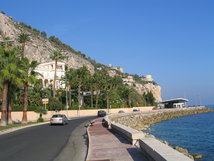Border: France-Italy-Monaco
Overview
Heterogeneous territories
The French-Italian border is characterised by the heterogeneity of the territories through which it runs. The cross-border space is marked by the expanse of the Alpine relief and by the coast, which has numerous similarities on both sides of the border, including its pronounced, complex relief and its linear urban development along the narrow coastal strip.
On the Alpine border, which separates predominantly rural, sparsely populated areas and protected natural spaces, cross-border cooperation is increasingly recognised as a major vector of sustainable development. The cooperation projects in the Mont-Blanc area (trinational with Switzerland) and between French and Italian nature parks are among the most advanced in Europe.
In the "High Valleys" cross-border territories (the Briançonnais district on the French side and the Piedmont valleys on the Italian side), the long-standing relations between the inhabitants are shaping cross-border cooperation within the territories, formalised by the establishment of the “Conferenza delle Alte Valli”, an association governed by Italian law which brings together the local authorities of the Greater Briançonnais and Maurienne districts and the Piedmont valleys.
Urban development is concentrated along the Mediterranean coast, comprising the three conurbations of Nice, Cannes-Antibes-Grasse and Monaco-Menton, and continues on the Italian side through the towns of Ventimiglia, Bordighera, San Remo and Imperia, forming a linear cross-border conurbation. On the Italian side, Turin is the principal economic centre. The cross-border hinterland is sparsely populated and enclaved, with the relief imposing substantial constraints.
The maritime border extends from the Var and Alpes-Maritimes departments to the islands of Corsica and Sardinia and to the coastal areas of Liguria and Toscana. The mountainous and enclaved geography of the islands has a profound social, cultural and economic impact on the territories. The two islands have to overcome problems related in particular to accessibility and transport. Other territorial issues concern energy, telecommunications, agriculture and economic development. In response, Corsica and Sardinia are jointly implementing cooperation actions, particularly on maritime affairs.
FLOWS CONCENTRATED ALONG A COASTAL STRIP
Except for the cooperation projects between the mountain territories and between the nature parks, local relations on the border are concentrated on a narrow coastal strip, some fifteen kilometres wide, between Nice and Imperia or, more precisely, between Monaco and San Remo.
In contrast to territories on either side of other French borders, cross-border home-work flows are not substantial. Worker movements between the two countries are concentrated almost entirely on the Mediterranean coast. 316 border workers1 residing in Alpes-Maritimes work in Italy. Most of these workers live in Nice and Menton and work in the neighbouring employment areas. In the opposite direction, an estimated 1500 Italian border workers come from the provinces of Imperia, Cuneo and the metropolitan city of Turin. Outnumbering their French counterparts by four to one, the border workers from Imperia province commuting to France live in the municipalities closest to the French border on the coast: Ventimiglia has 86 residents who commute to France for work.
Monaco is the second largest employment centre of this cross-border space, behind Nice. Most of these jobs are occupied by border workers. There are 38 426 border workers in Monaco, 3 696 (9.6%) of whom come from Italy. The rest (34 370) come from France, 29.2% of them from the adjoining French municipalities.
Cross-border interpenetration is nevertheless far from reaching the levels observed in the French-Swiss conurbation of Geneva or in the Lille-Kortrijk-Tournai Eurometropolis. Here again, cross-border relations are greatly subject to the mountainous relief, which prevents the formation of a continuous urban space. For example, Menton is separated from Ventimiglia by an Alpine ridge that plunges directly into the sea.
LOCAL FRENCH-MONACAN RELATIONS
The French-Monacan conurbation, consisting of the principality of Monaco and the neighbouring French municipalities, generates numerous local flows.
In this cross-border urban area, the Principality of Monaco, the local authorities and the deconcentrated services of the French state have to manage very local problems of planning, traffic, transport flows and parking, sanitation and public transport. These local issues are dealt with at two levels: by the joint French-Monacan cooperation committee and, pragmatically, by the Principality of Monaco, including through state-owned companies governed by Monacan private law (such as joint planning associations (SMA)).
The management of local issues is based on several French-Monacan agreements predating the French decentralisation process, which today is manifested by the incorporation into inter-municipal structures of municipalities neighbouring Monaco and by the introduction of new procedures for planning and contracting public investments.
2010 figures updated by the MOT.


